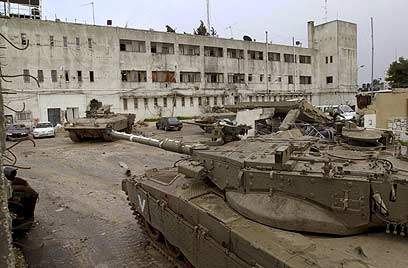
Operation Defensive Shield was a large-scale military campaign conducted by the Israeli Defense Forces in April 2002, after a series of terrorist attacks launched against Israel. The operation, which was held in the midst of the al-Aqsa Intifada, was meant to give the IDF renewed control over the West Bank, thereby enabling it to thwart terror attack on Israel.
The months following the eruption of the al-Aqsa Intifada saw the Palestinian terror organizations carry out numerous suicide attacks in Israel. The government's reaction to the murderous onslaught escalated over time and ranged from financial sanctions, through prohibiting Palestinians from entering Israel and bombing Palestinian government buildings, to the targeted assassinations of terrorist – none of which seemed to dent the terror groups' relentless attacks.
In 2002, the defense establishment came to the conclusion that the best way to the terror threat looming over Israel would be for it to regain control of the West Bank in general and the cities located in Area A – which is under the Palestinian Authority's sole control – in particular.
The catalyst for Operation Defensive Shield came in the form of a deadly Hamas attack carried out on March 27, 2002 – Passover – on the Park Hotel in Netanya. Casualties of the Park attack numbered in 30 dead and 150 injured; and in the days following the attack then-Prime Minister Ariel Sharon green-lighted the operation and authorized the Defense Ministry to declare an emergency draft of 20,000 reservists.

Detonation in Bethlehem, 2002 (Photo: AP)
Events unfold
IDF armor, gunnery and Air Force forces made their way into West Bank cities of Jenin, Bethlehem, Nablus, Qalqilya and Ramallah, on March 29; with the most intense fighting taking place in Jenin and Nablus. One the operation's first maneuvers entailed placing a siege on the Mukataa in Ramallah, where Palestinian Authority Chairman Yasser Arafat's office was. Once the IDF took over the compound, Arafat would be unable to leave it again, until his hospitalization in 2004.
The operation's most notorious battle took place in a refugee camp in Jenin, 10 days into the campaign: An IDF reservist force which ventured into the camp to perform a security canvass was hit by explosives and the soldiers sent in to extract the wounded met with heavy artillery fire. The subsequent clash left 13 soldiers dead.
Jenin proved a tough adversary and the IDF had no choice but to deploy heavy armored vehicles in order to take the camp, eventually declaring the entire area a restricted military zone. The Palestinians were quick to claim that the IDF's actions equaled a massacre, alleging the Israeli forces killed 500 of the camp's inhabitants. The UN declared it would be forming a commission of inquiry into the events that took place in Jenin, but the commission soon dispersed.
A subsequent UN report published in august of 2002 exonerated Israel from any allegations of massacre in Jenin. The report did, however, chide Israel for using excessive force against civilian population. The report also condemned the Palestinian Authority for allowing civilians to be used a human shield against the IDF.

Siege on the Mukataa, Ramallah (Photo: AP)
Though the Palestinian Authority and the terror groups operating within it suffered a massive blow in the operation, its long-term effectiveness remains controversial, as shortly after it was concluded terror attacks on Israeli targets resumed.
Operation Defensive Shield came to its official end on April 21, 2002, with the IDF pulling its forces from the Palestinian cities. The military did, however, continue launching small, limited operations throughout the West Bank.
The operation saw the IDF suffer 29 fatalities and 127 casualties. The Palestinians reported of 250 deaths and 400 casualties. Some 5,000 Palestinians were arrested, including former Fatah Secretary-General in the West Bank Marwan Barghouti. The IDF also seized massive quantities of weapons and explosives and uncovered 23 explosive labs.














